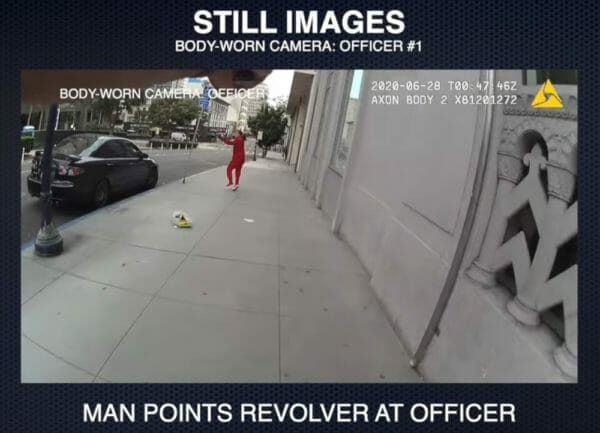U.S.A. –-(AmmoLand.com)- A bit before 6 p.m., in downtown San Diego, California, two police officers noticed a man in a red tracksuit. He was wanted in connection with a recent robbery. He had a distinctive face tattoo, which is how the officers identified him so quickly.
In the ensuing confrontation, the suspect flees from the police, He drops what he is carrying, and is shot.
Protestors claim he was shot without justification. The next day, a hundred protestors gather. They threatened to “burn down the system“.
The San Diego police act quickly. They released a video of the shooting from four sources, including two police body cameras.
The video shows the suspect drawing a revolver and pointing it at police just moments before police open fire.

The well-done release by the San Diego Police took control of the narrative. It is worth watching and studying. It shows how easy it is to justifiably shoot someone in the back in defense of self and others.
Many have said shooting someone in the back is never justified. That is false. Real-world defensive shootings are seldom static.
They are fast, dynamic, and changing quickly. Adversaries are often moving, twisting, and turning.
It takes a fraction of a second from the time a decision is made to shoot, to the gun actually firing. In that time the position of a moving adversary can change quite a bit. Just because a person’s back is momentarily turned toward you, does not stop them from being a deadly threat.
Ubiquitous security cameras and recording devices are making it harder and harder to characterize events in a simple, deceptive narrative.
Video can be used to create a false narrative. It is done most often by groups or individuals with an agenda. In the George Floyd case, major networks cut the video before it showed a police officer saying, when asked why they did not put Floyd in the car, that they had been trying to do that for several minutes.
Floyd resisted so vigorously, three officers could not secure him in the car.
A similar situation occurred in Los Angeles before the Rodney King riots. All the officers actions were justified, and in accordance with policy, but the major media cut the video to make it appear damning to police.
In this case, with four cameras, different angles, and the still shots released, the story is clear. It stopped another budding, anti-police narrative cold.
In Minneapolis, the City Government has still not released the body camera video.
The revolver shown, in the possession of the suspect, appears to be a Uberti replica of the cartridge conversion of 1851 Navy Colt cap and ball revolver. The replicas are chambered in .38 special.

The replicas have a reputation as a reliable and accurate revolver.
Note the revolver was tucked in the waistband, in a bandana. It was not in a holster. Criminals almost never use holsters, because a holster ties them to a gun, and is not easily disposed of.
Video evidence is becoming ever more important. The ability to record an event is becoming as important to a defender after the event, as having the ability to defend yourself, during the event.
About Dean Weingarten:
Dean Weingarten has been a peace officer, a military officer, was on the University of Wisconsin Pistol Team for four years, and was first certified to teach firearms safety in 1973. He taught the Arizona concealed carry course for fifteen years until the goal of Constitutional Carry was attained. He has degrees in meteorology and mining engineering, and retired from the Department of Defense after a 30 year career in Army Research, Development, Testing, and Evaluation.
